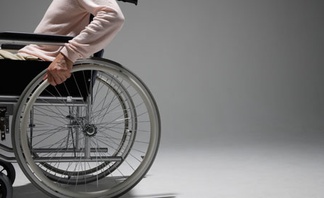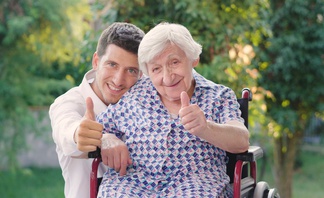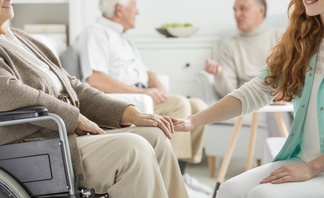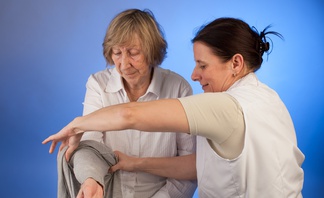Anyone can slip and fall in the bathroom but seniors who have poor muscle strength, problems with balance and coordination, or vision impairment, are at greatest risk. Bathrooms are particularly hazardous because of the slippery and hard unforgiving surfaces.
More than one in three adults over the age of 65 fall each year, often at home. Up to eighty percent (80%) of these falls in the home occur in the bathroom. According to a 2011 study from the Centers for Disease Control and Prevention (CDC), nearly 200,000 Americans are treated in emergency departments for bathroom-related injuries annually.
The good news is that many falls can be prevented with some simple measures.
The first step is to take a look at your existing bathroom setup to identify the easiest to correct fall risks…
- Is there enough lighting?
- Is there clutter that could contribute to tripping?
- Does getting in and out of the tub or shower require taking a big and high step?
- Are towel racks being used for weight support?
- Are all floor surfaces, shower chairs and slip resistant? Could any of these surfaces become slippery when wet?
- Are there sliding glass doors that could move unexpectedly when entering or exiting the tub?
- Is the toilet seat height so low that it’s hard to sit down and get up from it?
- Is walking to the bathroom at night safe?
- If you or an elderly loved one were to fall in the bathroom without anyone around, could you get help?
If the answer was “yes” to any of the above questions, then read on for the solutions to address these problems and more…
Lighting
Having nightlights that create a well-lit path to and in the bathroom are easy to install. The best nightlights are the ones that will automatically turn on in ambient darkness.

Clutter
Remove bathmats, rugs, laundry baskets etc. that could be a tripping hazard.
Tub transfers
Taking a step over a tub’s high sides can be very destabilizing. Many falls happen at the time of entering or getting out of the tub. Here are three measures that can be used alone or together to decrease this risk:
- Wall-mounted grab bars. May people use towel racks or other bathroom fixtures for support. However, these are designed for holding towels or similar lightweight items and not for taking the full weight of an adult during a fall. Grab bars that are bolted to the wall studs should be used for weight support. Avoid bars that attach by suction cups since these can slip. Grab bars should be positioned where they are in easy-to-reach places where a change in position (e.g. from sitting to standing, a turn or entrance into a tub) is anticipated. Choose grab bars that have slip resistant grips and in a color that contrasts to the wall for good visibility. Grab bars are best suited for people with good upper-body strength and ability to maintain a hand grasp.

- Tub-attached grab bars. "Clamp on" safety bars can be easily tightened onto bath tub rims without structural damage to the tub or walls.
- Shower benches. A shower bench can provide stability for someone who has difficulty balancing or who has trouble standing for long periods of time. In addition, a well-positioned shower bench can aid in bathtub or shower stall transfers. You would sit on the bench from the outside of the tub or shower and only after being safely seated, then the legs would be brought over into the tub or shower stall. A good shower chair has rubber tips on the legs to prevent sliding and should be constructed out of materials that can withstand water without rust or other water damage and won’t pool water.

Non-slip surfaces
- Non-slip mats and rugs. Having a non-slip rubber mat on the floor of the shower or tub as well as a non-slip rug on the floor when stepping out of tub or shower can help significantly in preventing slipping on wet tiles. Stepping onto a towel is bad because a towel can easily slide away. A non-slip rug in front of the toilet and by the sink area can reduce slipping on wet tiles. Again, choose colors that give high contrast against the floor for increased visibility.

- Non-slip adhesive strips. In addition to placement on floor surfaces, they can be placed on the top of sink edges to guard against hand slippage if these surfaces are used for balance support.
Movable supports
Make sure that surfaces or objects in the pathway into or inside the bathroom that could end up being used as a hand hold are fixed and would not give way if weight were applied to them.
Toilet seat height
- Raised toilet seats. Many people who have muscle weakness, find it very difficult to lower and rise to a standing position with standard toilet seat heights. A raised toilet seat (raises toilet seat height by 3-4 inches) reduces the amount of squatting and the distance that has to be covered to sit on the toilet.
- Grab bars. Grab bars either on the wall or on the raised seat itself provide added safety.
Bathroom trips at night
Bedside commodes. If getting up and going to the bathroom at night could be a risk for falls then a bedside commode could be very helpful. These come with removable bucket like receptacles for waste that are easy to clean.

Home alone
- Personal alert systems. These come with either a bracelet or pendant that will trigger an emergency alert system when a button is pressed. Some come with motion detection to respond to a sudden fall. Staff who are available 24/7, will then call emergency medical response services and family members to check on the client. Families usually buy the units and pay a monthly service subscription.
- Bathroom Telephone. Since many falls occur in the bathroom, it may be wise to Install an additional telephone in the bathroom. It should be placed at a low enough height that it can be reached from someone laying on the floor.
- Bathroom Doors. It is best to have outward swinging doors that will allow caregivers and emergency personnel access in the event the person who fell could block the door shut.
Additional Safety Tips
- Put toiletries within reach. Falls can occur when stretching or bending down for something. Therefore make sure frequently used toiletries are always easily within reach.
- Regular Cleaning. Routinely ridding showers and tubs of soap scum and mildew can reduce the slippery coating that forms as a result of these substances.
Please take a moment to view these videos for additional tips and insights in preventing bathroom falls:
- How to Make the Bathroom Safer for your Elderly Parent from the Visiting Nurse Service of New York
https://www.youtube.com/watch?v=4QvgHtiRjV8
- Bathroom Safety Solutions for Fall Prevention from the Arizona Fall Prevention Coalition
https://www.youtube.com/watch?v=LW9nXuAlAbw






